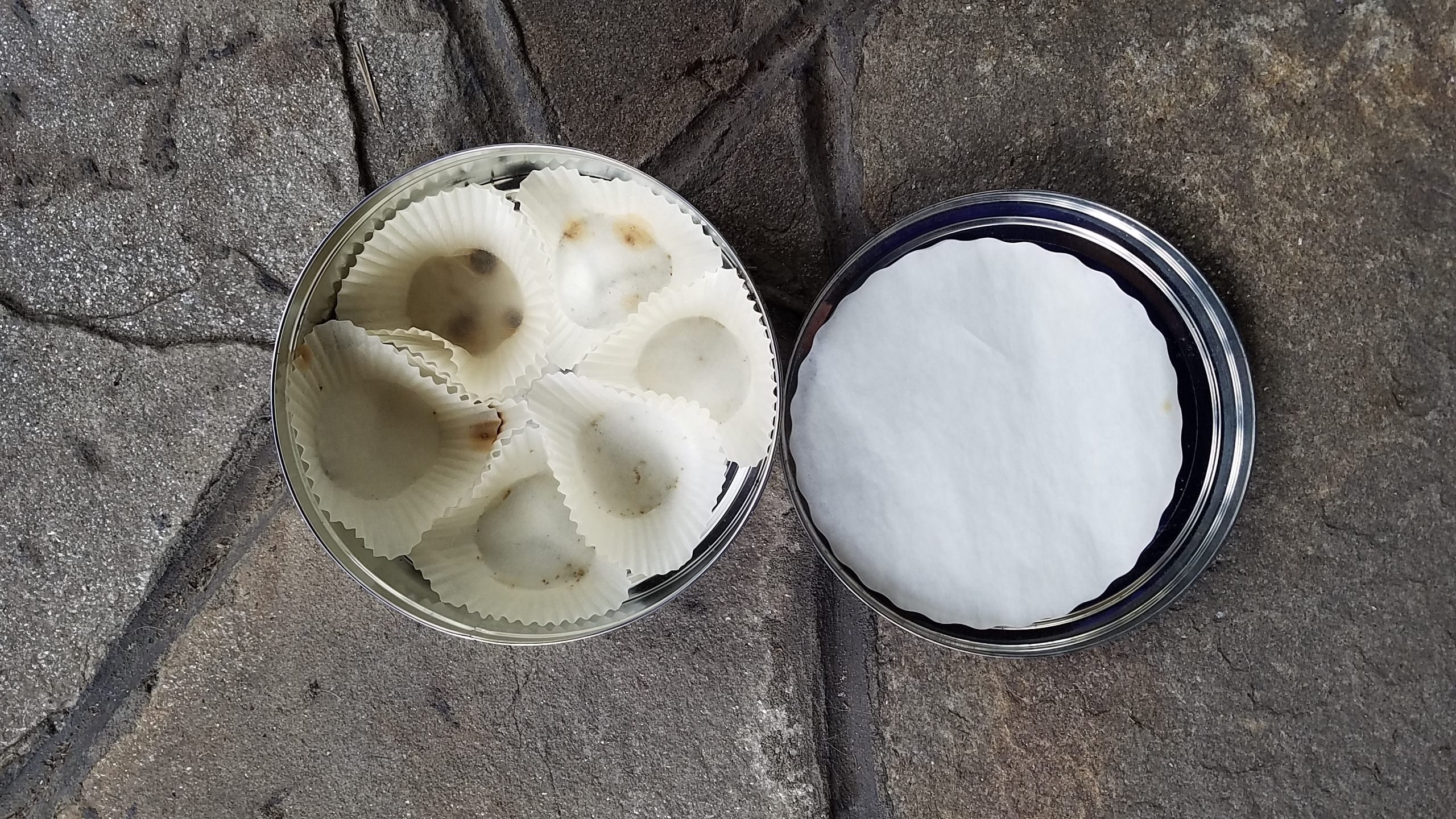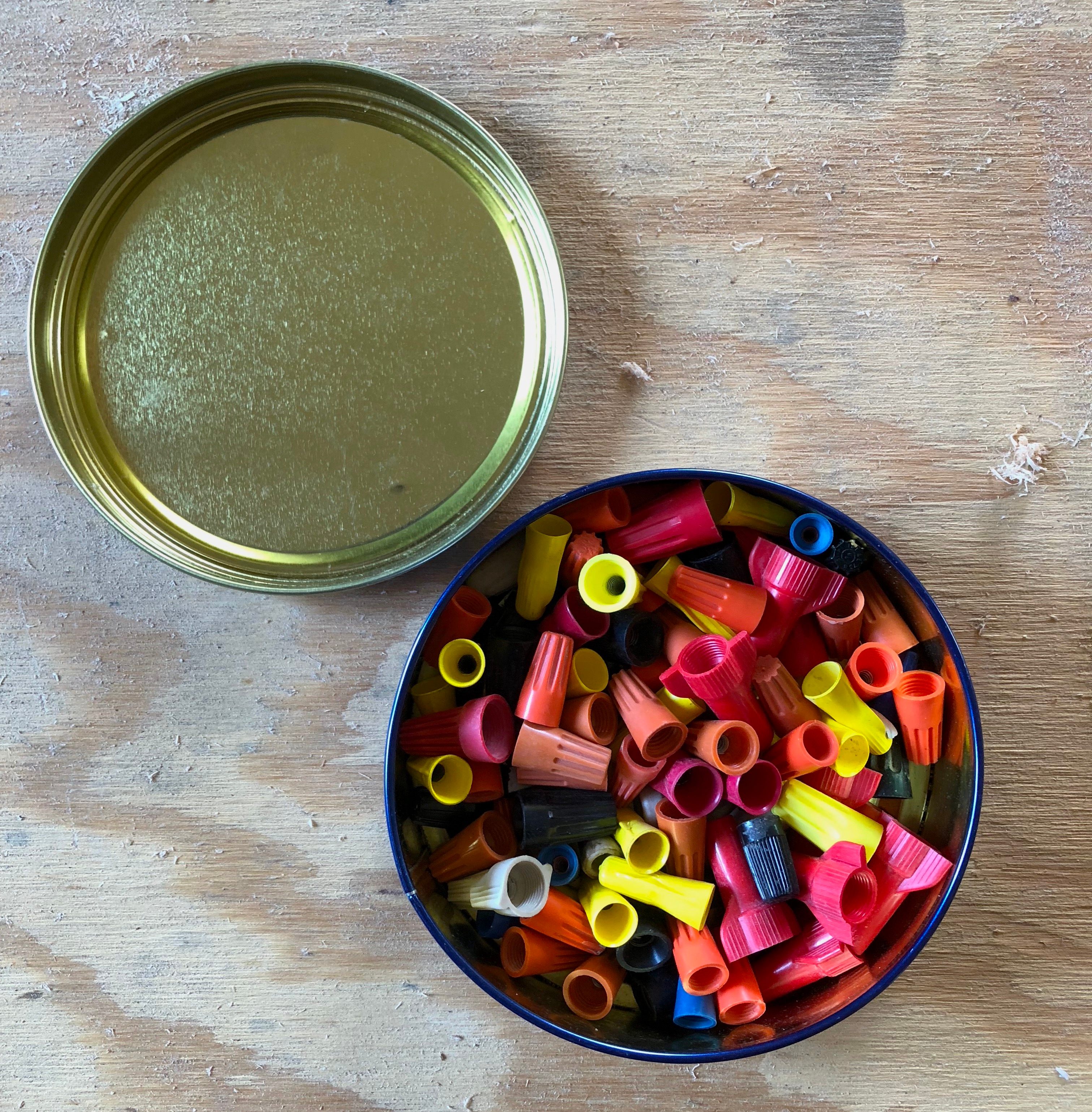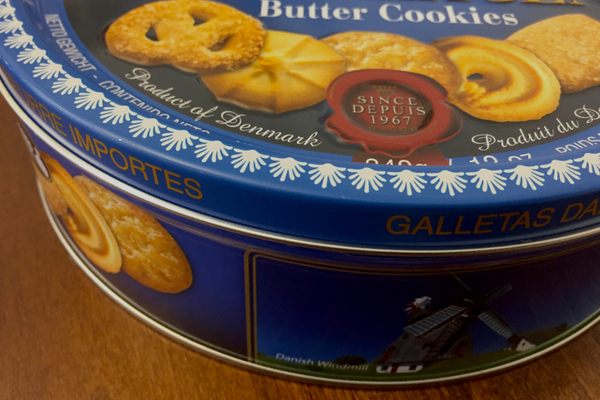Sewing Kits, Umbilical Cords, and Mold: Here’s What You Keep in Royal Dansk Tins
Storing buttons and baubles in these cookie containers is a phenomenon.

Several weeks ago, we asked Gastro Obscura readers to send in accounts of what they have found (or now keep) inside their Royal Dansk cookie tins. We were investigating a curiosity: The tins always seem to hold odd trinkets, and more often than not, cookies are nowhere to be found.
Nearly 250 of you wrote in, from El Salvador to South Africa, from Hanoi, Vietnam, to Harrisburg, Pennsylvania, with tales of unearthing knickknacks and oddities. This often led to initial confusion for children: Why was there a cookie tin with no cookies lying around? But the result was often a sort of at-home treasure hunt—linked to memories and family—whose marvels far surpassed the momentary delight of biting into a butter cookie.
The overwhelming majority of readers—100 total—described finding sewing supplies inside their family’s cookie tins. (We accepted tins from any brand, but Royal Dansk were by far the most common.) The tendency to store sewing supplies is shared by grandparents, parents, and children cross-culturally. It’s so common that it’s the frequent fodder of Reddit subthreads, memes, and much-retweeted tweets. And as this account proves, it seems to be a century-old tradition:
My mom stored sewing supplies in her cookie tin. I didn’t know it was a cultural phenomenon—at the time, I just thought it was kind of weird. Then, one day, I was cleaning out my grandparent’s storage under the stairs and found a tin that had belonged to my grandmother’s mother. And what was inside? Sewing supplies from the 1920s! I think it’s funny how something so ubiquitous can be reused and recycled as storage for all kinds of things, be it personal mementos or common household goods.
–Prisca, Toronto, Canada

Many people remember feeling dismayed to find sewing kits rather than cookies as children—and yet, they often picked up the habit themselves. It’s now clearly a cross-generation practice:
I found sewing supplies and was very disappointed … [But now] I keep sewing supplies, and I’ve had it for 15 years.
–Anna Butiashvili, Tbilisi, Georgia
My family has always kept sewing materials and buttons in ours. When I moved out, I did the same with a small tin of Royal Dansk.
–Iva Yates, Ireland but am from Puerto Rico
Another 71 readers found buttons in their cookie tins—the second most commonly stored item. Several respondents described entire tins bursting with just buttons. Others discovered them alongside other stitching supplies, such as classic tomato pincushions, which suggests an extension of the sewing kit phenomenon. And much like the sewing supplies, the buttons often achieved a second life after their original owners passed on:
I keep the “family” button collection, which includes buttons going back to the 1900s and my great-grandma Mary. She saved every button, especially from coats, and reused everything! After her, my grandmother Ethel and my mom and now I add to it. I never use the oldest ones; they’re too sentimental. As kids, my sisters and I would use the large buttons as pretend money. I suppose I’ll pass the tin on to my sister’s daughter someday, as I have no kids of my own. I hope she’ll treasure it as much as we did.
–Cndy, Central Oklahoma
How and when this trend started is a mystery. But there are some convincing explanations floating around. While Royal Dansk began manufacturing their tins in the 1960s, they weren’t the first company to do so: The English biscuit maker Huntley and Palmers did in the 19th century. When travel across the pond started happening more frequently in the 20th century, people’s hunger for the tins increased, as Smithsonian notes. So when these striking blue tins arrived, people saw them not as disposable, but rather as natural storage containers:
My paternal grandmother saved every button and kept them in a cookie tin. She survived the Depression as a young widow with a son to support and elderly parents who needed care, so waste-not-want-not was her mantra. Buttons were clipped from worn garments (only after years of mending) and saved in perpetuity in her button tin. As a child, I loved to look through the collection, find matches, and admire the vintage styles.
–Judith H Sumner, Worcester, Massachusetts

Filling the tins with other cookies evolved into an obvious re-use, and 20 Gastro Obscura readers recounted stories of finding replacement snacks (usually homemade cookies) in the tins. Others repurposed the tins for flan, tortillas, or—as three Indonesian readers told us—a specific kind of cracker. “Usually I found Rengginang inside,” writes Nita Permata Kusuma. “Rengginang is a rice-cracker native to Indonesia.”
Of course, the tins frequently become containers for regifted cookies and transporting other foods. Along the way, they kickstart traditions, too:
A friend of ours from Moscow, Russia came here on business. In the town of Canela, as we went shopping in a chocolate store, our friend decided to buy a heart-shaped piece of chocolate (which had no filling, so it was quite fragile). He wondered aloud how to take it back home to his beloved without shattering it … I exclaimed: “Denmark!” I rummaged home for a Royal Dansk tin and handed it to him. We tried fitting the heart inside it, but the tin’s height was insufficient. In the end, he found another way involving bubble film, and the chocolate heart arrived unscathed.
In February, it was my turn to go to Moscow, and I decided to bring them an unopened tin, full of Royal Dansk cookies! They invited me to have dinner in their home, and as dessert we all ate the cookies, emptying it in one night. She, despite having liked the cookies, was a little bit confused about my enthusiasm for it: It was only then that he explained to her that such a tin had been one of our first attempts to secure the chocolate heart for its transatlantic trip. Afterwards, I asked them to uphold the tradition. I already wondered what interesting stuff they would keep in theirs!
–Germano Martinelli, Porto Alegre, RS, Brazil
Every response confirmed the cookie tin’s staying power. Much of it appears to do with the pleasing, round shape of the tin, which applies to both Royal Dansk and other cookie-makers:
Mine is a vintage round blue “Wedgwood” Huntley and Palmers biscuit tin, and I use it to store a stack of clean facecloths for washing the face and wrinkles of my little messy pug after he’s had a meal. A bonus is that the tin looks great in my blue and white kitchen!
–Lisa Baker, Alameda, California

Aside from sewing supplies, many people reported finding curiosities such as skeleton keys, and keys that led to nowhere, in their family’s tins:
The cookie tin can of my childhood lived in the Cuarto de San Alejo. (A closet named after a saint, full of old stuff.) I don’t know if it was every key to every door to every room of every house that my grandparents and parents had ever lived in, but that tin held easily 50 keys. I tried every key on every door. None worked.
–Camilo Forero, Bogotá, Colombia
Additional bits and baubles included (but weren’t limited to) wooden cameras, shark teeth, art supplies, rock collections, band patches, batteries, Tarot cards, pumpkin carving tools, church gloves, matchbooks, cards, dice, wires, pocket knives, small fortunes, jewels, and antique hair care supplies:
My aunt was a hairdresser in the early 1930s. When she died, we found a cookie tin under her bathroom sink. It contained metal hair clips of the spring-back, curved type, used by beauticians in the early part of the 20th century, to make the defined parallel waves of the “Marcel” hair style. Also in the tin were three loose, fairly large diamonds that my aunt had removed from the very old, broken rings she had inherited from her own aunt decades earlier.
–Jeannie, Ashland, Oregon

Some tins held never-before-seen troves of family photos that survived disasters and death:
My father handed me a cookie tin about a year after my grandmother passed away. More valuable than anything, it contained pictures of me and my siblings. We had a fire in our house when I was a kid, and all photos of us as young children were destroyed. These photos that my grandmother kept were more precious than gold. I had never seen a baby picture of myself until I opened that tin. I made copies of some of the photos for my brothers and sister.
–Susan Ericson, Red Bank, New Jersey
A “tin type” photo of my brother who died just before his first birthday. Doyle was my parents’ first child, born in 1920.
–Sheila, Washington State
Others encountered more illicit offerings. Ashley, from Illinois, writes of finding “a bottle of vodka and a Bible.” And Bee, hailing from California, is one of the handful of readers who found the family cannabis stash in a tin (“I knew she smoked. But the cookie tin? Really, mom?” she writes). Some tins became the sites of peculiar personal experiments, too:
When I was a kid, around 1970 or so, I kept my mold collection in a tin. One Christmas, after the cookies were gone, I put a few pieces of bread, cake, and other perishables in one. Then I left it in my closet for a year. The next Christmas, I opened it to see what had happened. There were molds of many different colors. I remember bright orange mold in particular. I added a few small pieces and sealed it up again for another year. This continued for about five years, until one Christmas, I went to check on the progress, and the metal had corroded away in a large section. All the mold had turned to black dust, and I decided that this was a sign to move on.
–Jon Peterson, Minneapolis, Minnesota

We heard from a few people who discovered entire caches of tins, each home to a world of individual wonders:
My papaw (father’s father) died in April of last year. While helping my daddy clean and sort through everything Papaw left behind (and Granny, who preceded him in death by four years), we found many Royal Dansk cookie tins. Many different things filled these tins: buttons and sewing supplies left by my Granny; packets of heirloom seeds from the garden started by my great-great-grandmother in the holler of Kentucky, labeled in my Papaw’s tight penmanship; a time capsule my daddy had assembled as a kid, filled with photos, baseball cards, a bouncy ball, jacks, and a kazoo. And the most thrilling and special find of all … My granny’s wedding ring. The thin gold band given to her by my Papaw the day they wed over 60 years ago, placed in a tin the day she was buried, and forgotten in the ensuing years. Finding those tins was one of the best moments of my life, and I was so blessed and overwhelmed to have been there for that discovery.
–Rachael, Chandler, Arizona
Other readers stumbled upon more peculiar heirlooms—sometimes of the corporeal variety. Kris McElwee, of Paris, recalls finding “my grandmother’s braid, cut off when she married,” in one tin. And someone found something they hadn’t seen since birth:
[The tin held] a sewing kit and mementos from my birth: my umbilical cord, my tag in the neonatal room, etc … Another cookie tin held letters from my dad to my mom from the time they made long distance, before me and my sister. That was cute.
–Victoria Mallorga, Lima, Peru

What we learned from these responses is that these tins are continuously passed down, regardless of their contents, to family members, friends, and even new homeowners or strangers. It’s become tradition to inherit a tin, just like old jewelry, mugs, or other mementos. More than anything, we discovered that the Royal Dansk cookie tin isn’t going anywhere—even though it has instigated family feuds:
Some of our tins are at least as old as I am (38). It was my grandfather’s tradition to send us a tin of cookies for Christmas—and our tradition of fighting over who got to fill the empty container after.
–Sarah J Moore, Fayetteville, Arkansas
Here at Atlas Obscura HQ, we’re down to the last butter cookie in our Royal Dansk tin. We can’t wait to decide how to fill it again.
Gastro Obscura covers the world’s most wondrous food and drink.
Sign up for our regular newsletter.




























Follow us on Twitter to get the latest on the world's hidden wonders.
Like us on Facebook to get the latest on the world's hidden wonders.
Follow us on Twitter Like us on Facebook